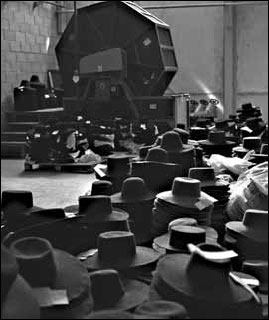For Spanish hats, unlikely customers
Updated: 2012-08-12 07:53
By Doreen Carvajal (The New York Times)
|
||||||||
|
|
SEVILLE, Spain - Since its founding 127 years ago, the Fernandez y Roche factory on the edge of this Andalusian capital has weathered every crisis known to hatters.
It surmounted the 1930s "hatless" trend. It survived the sliding popularity of the birettas and saturnos worn by Roman Catholic priests. And, now, it is weathering a decline in Spanish sales of the stiff-brimmed cordobes hat favored by horseback riders and the occasional bullfighter.
But despite the Spanish economic crisis, the hat company is thriving, thanks to an unlikely revenue base: the sales of thousands of black hats each year to Satmar Hasidic Jews in Jerusalem and Brooklyn.
"They are saving us in the crisis," said Miguel Garcia Gutierrez, 35, the managing director of the Roche factory, officially known as Industrias Sombrereras Espanolas, which operates in an industrial park in Salteras, about 14 kilometers outside Seville. "We have an important market in Spain for traditional hats, but with the crisis those sales have fallen for the last three years, between 20 and 30 percent. But our exports are rising for hats for Orthodox Jews."
The Satmars, one of the largest Hasidic sects with more than 150,000 members, left Hungary and Romania after World War II and settled in Brooklyn, New York, their main stronghold. There are also communities in Jerusalem and London.
The Spanish factory began supplying hats to the group's enclaves in Brooklyn in 1980, after an American hat maker shut down and a Brooklyn store, Kova Quality Hatters, started looking for new manufacturers.
Today, the factory sells more than 12,500 basic black felt hats a year - largely purchased by the growing Satmar sect. More than 70 percent of all their hats are exported to the United States, England, Japan, Belgium and Israel.
The hats for the Orthodox Jewish market are not listed in any catalog or Web site. The three popular models make distinctive fashion statements summed up by their names: Bent Up, Snap Brim and the Clergy, which lacks a crease in the crown and is bound around the brim.
Barely perceptible differences in plain black hats are important markers, according to Ester Muchawsky-Schnapper, the curator of a popular exhibit at the Israel Museum in Jerusalem on the lives and customs of Hasidic Jews.
"You can differentiate the different groups by their hats," she said.
In Brooklyn, Albert Ehrman is the second generation in his family to run the half-century-old Kova Quality Hatters from a brick storefront. He travels each year to southern Spain with his wife, Miriam, to personally inspect the Clergy hats, the most popular with his Satmar clients. This summer, he spent hours with a small metal ruler, measuring hat brims for uniformity and demanding a "good, sharp edge" for the Clergy, which lately have been narrowing and selling for up to $175 in the United States.
A visit to Kova is a rite of passage for generations of families who bring children in when they turn 13 to choose their "Roche," as the hats are often called.
"The male identity is so profound in the community," said Simon Yisrael Feuerman, 49, a New Jersey psychotherapist who wears a Snap Brim and is one of three generations of loyal Roche customers who shop at Kova.
"A visit to Kova is really the one time that they act with vanity. They keep looking at the hat," he said. "The differences are crucial once they put on the Roche. Is this brim too big? Does this make me too fat? There is nothing more important than the hat. Nothing. Not even nuclear war."

 Relief reaches isolated village
Relief reaches isolated village
 Rainfall poses new threats to quake-hit region
Rainfall poses new threats to quake-hit region
 Funerals begin for Boston bombing victims
Funerals begin for Boston bombing victims
 Quake takeaway from China's Air Force
Quake takeaway from China's Air Force
 Obama celebrates young inventors at science fair
Obama celebrates young inventors at science fair
 Earth Day marked around the world
Earth Day marked around the world
 Volunteer team helping students find sense of normalcy
Volunteer team helping students find sense of normalcy
 Ethnic groups quick to join rescue efforts
Ethnic groups quick to join rescue efforts
Most Viewed
Editor's Picks

|

|

|

|

|

|
Today's Top News
Health new priority for quake zone
Xi meets US top military officer
Japan's boats driven out of Diaoyu
China mulls online shopping legislation
Bird flu death toll rises to 22
Putin appoints new ambassador to China
Japanese ships blocked from Diaoyu Islands
Inspired by Guan, more Chinese pick up golf
US Weekly

|

|







